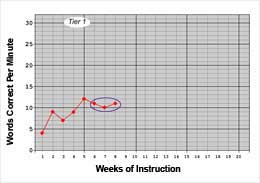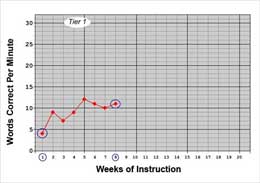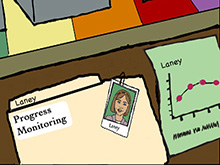How can Tier 3 intervention be implemented?
Page 4: Determining Which Students Will Receive Tier 3 Intervention
Most of the students who require Tier 3 intervention have difficulty decoding words, reading fluently, and comprehending what they have read. Additionally, they often lack:
-
- Phonological awareness and knowledge of the alphabetic principle
x
Phonological awareness
Phonological awareness is the recognition that spoken language can be broken into smaller components and the ability to manipulate these components.
xAlphabetic principle
The alphabetic principle refers to the relationship between sounds and written letters.
- Verbal knowledge and strategies that are needed for reading comprehension
- Experience with letters, print, and language prior to entering kindergarten
- Motivation to read or an appreciation for reading, often due directly to their reading struggles
- Phonological awareness and knowledge of the alphabetic principle
Listen as Doug Fuchs describes some of the other characteristics of students who might benefit from Tier 3 intervention (time: 1:12).

Doug Fuchs, PhD
Nicholas Hobbs Endowed Chair in Special Education and Human Development
Vanderbilt University, Nashville, TN
Transcript: Doug Fuchs, PhD
Stephanie Alitayba and I did a literature review several years ago. And we were looking at young children, and we were looking in the area of reading. Lexical retrieval was problematic. Other kinds of language functioning was weak. Attention was a big issue. A lot of kids who show up as unresponsive in the primary grades have very poor attention. They’re distractible. They’re disorganized. They’re often off-task. They have difficulty maintaining focus, all of which really conspire against such kids functioning in complex and stimulating general education classrooms. As the kids get older, there is an entirely different additional layer of problematic behaviors. There’s very low motivation. There’s negative attitudes towards school and learning. There’s self perception problems that complicate things. There’s deliberate resistance to efforts in instruction. There’s no one thing, two things, three things. There’s usually a constellation, and the constellation changes as the children mature.
The Tier 3 Eligibility Process
Not Making Adequate Progress in Tier 2
To determine whether a student requires the more intensive, individualized intervention provided in Tier 3, it is first necessary for teachers or a team to examine the student’s Tier 2 progress monitoring data. Several methods may be used to determine whether a student is making adequate progress. Most involve meeting performance level or rate of growth criteria.
Performance level is an indication of a student’s reading skills, usually denoted by a score on a given test or probe. It is represented on the vertical axis (or y-axis) on a graph of the student’s scores.

Rate of growth indicates how much a student’s reading skills are improving. This is represented by the slope on a graph of the student’s scores.

Performance Level graph: This is a line plot graph showing a student’s performance level. The x-axis is labeled “Weeks of Instruction.” Weeks 0 through 22 are shown, with every two weeks labeled on the axis. The y-axis is labeled “Words Correct Per Minute.” 0 to 30 correct words per minute are shown, with every five words correct per minute labeled on the axis. There is a red line plot graph stretching from Week 1 to Week 8. This period of time is labeled “Tier 1” at the top of the graph. The data line has eight plotted points at weeks 1 through 8. The points per week are as follows: 4, 9, 7, 9, 12, 11, 10, and 11 words correct per minute. The last three data points are circled in purple.
Rate of Growth graph: This is a line plot graph showing a student’s rate of growth. The x-axis is labeled “Weeks of Instruction.” Weeks 0 through 22 are shown, with every two weeks labeled on the axis. The y-axis is labeled “Words Correct Per Minute.” 0 to 30 correct words per minute are shown, with every five words correct per minute labeled on the axis. There is a red line plot graph stretching from Week 1 to Week 8. This period of time is labeled “Tier 1” at the top of the graph. The data has eight plotted points at weeks 1 through 8. The points per week are as follows: 4, 9, 7, 9, 12, 11, 10, and 11 words correct per minute. The first data point and the last data point are circled in purple. The corresponding weeks with these two data points, Week 1 and Week 8, are also circled in purple on the x-axis.
In the dual discrepancy approach, teachers examine both performance level and rate of growth for the Tier 2 data. According to any of these methods, students’ response to intervention is defined as:
- Adequate progress: The student’s scores are at or above the established criterion.
- Inadequate progress: The student’s scores fall below the criterion.
For Your Information
According to available research, the dual discrepancy approach appears to be the most effective method for monitoring the progress of English learners. However, researchers remind us that the criteria used to assess performance level (i.e., benchmark) and rate of growth are determined by a norming sample in which these students are often not included.If you do not already have a comprehensive understanding of data-based decision making in the RTI approach, we encourage you to examine the following IRIS Modules:
(Close this panel)
If the data indicate that the student is not making adequate progress in Tier 2, he or she should be considered for Tier 3, or special education, services. However, to qualify for special education services under current law, students must meet certain criteria: 1) a student must have a disability, and 2) that disability must significantly affect his or her educational performance. The formal process for determining whether a student is eligible for Tier 3 services consists of three basic steps:
- Referral
- Evaluation
- Determination of eligibility for special education
Referral
Based on a student’s progress in Tier 2, school personnel may refer a student for special education services. Once the referral is made, school personnel and parents should meet to review the student’s progress (e.g., Tier 2 progress monitoring data, work samples) and to decide whether an evaluation for special education services (i.e., Tier 3 intervention) is warranted.
Evaluation
The purpose of the evaluation is to rule out other possible factors for the student’s academic performance, and, in turn, to indicate whether the student does in fact have a learning disability (LD). Factors to rule out include:

- The existence of other disabilities (e.g., intellectual and developmental disabilities, visual impairment, hearing impairment, emotional or behavioral disorder)
- A lack of appropriate reading instruction
- A low level of English proficiency
- An environmental or cultural disadvantage
- Low motivation
- Situational trauma (e.g., the death of a parent)
Ruling these factors out will require school personnel to make use of multiple sources of information. Though they often begin by administering the assessments noted in the table below, the IEP team may request other assessments to gain additional information about a student.
| Assessment | Purpose |
|
To eliminate vision or hearing deficits as causes of learning problems |
|
To eliminate intellectual and developmental disabilities as a cause of learning problems |
|
To eliminate speech or language impairments as a cause of learning problems |
|
To eliminate an emotional or behavioral disorder as a cause for academic failure |
Because the student’s progress monitoring data can serve as a measure of achievement, an achievement test is often not included in the evaluation. However, the specific measures required as part of this evaluation vary by state.
Sec. 300.304 Evaluation procedures.
(a) Notice. The public agency must provide notice to the parents of a child with a disability, in accordance with Sec. 300.503, that describes any evaluation procedures the agency proposes to conduct.
(b) Conduct of evaluation. In conducting the evaluation, the public agency must–
(1) Use a variety of assessment tools and strategies to gather relevant functional, developmental, and academic information about the child, including information provided by the parent, that may assist in determining–
(i) Whether the child is a child with a disability under Sec. 300.8; and
(ii) The content of the child’s IEP, including information related to enabling the child to be involved in and progress in the general education curriculum (or for a preschool child, to participate in appropriate activities);
(2) Not use any single measure or assessment as the sole criterion for determining whether a child is a child with a disability and for determining an appropriate educational program for the child; and
(3) Use technically sound instruments that may assess the relative contribution of cognitive and behavioral factors, in addition to physical or developmental factors.
(c) Other evaluation procedures. Each public agency must ensure that–
(1) Assessments and other evaluation materials used to assess a child under this part–
(i) Are selected and administered so as not to be discriminatory on a racial or cultural basis;
(ii) Are provided and administered in the child’s native language or other mode of communication and in the form most likely to yield accurate information on what the child knows and can do academically, developmentally, and functionally, unless it is clearly not feasible to so provide or administer;
(iii) Are used for the purposes for which the assessments or measures are valid and reliable;
(iv) Are administered by trained and knowledgeable personnel; and
(v) Are administered in accordance with any instructions provided by the producer of the assessments.
(2) Assessments and other evaluation materials include those tailored to assess specific areas of educational need and not merely those that are designed to provide a single general intelligence quotient.
(3) Assessments are selected and administered so as best to ensure that if an assessment is administered to a child with impaired sensory, manual, or speaking skills, the assessment results accurately reflect the child’s aptitude or achievement level or whatever other factors the test purports to measure, rather than reflecting the child’s impaired sensory, manual, or speaking skills (unless those skills are the factors that the test purports to measure).
(4) The child is assessed in all areas related to the suspected disability, including, if appropriate, health, vision, hearing, social and emotional status, general intelligence, academic performance, communicative status, and motor abilities;
(5) Assessments of children with disabilities who transfer from one public agency to another public agency in the same school year are coordinated with those children’s prior and subsequent schools, as necessary and as expeditiously as possible, consistent with Sec. 300.301(d)(2) and (e), to ensure prompt completion of full evaluations.
(6) In evaluating each child with a disability under Sec. Sec. 300.304 through 300.306, the evaluation is sufficiently comprehensive to identify all of the child’s special education and related services needs, whether or not commonly linked to the disability category in which the child has been classified.
(7) Assessment tools and strategies that provide relevant information that directly assists persons in determining the educational needs of the child are provided.
(Authority: 20 U.S.C. 1414(b)(1)-(3), 1412(a)(6)(B))
Determination of Eligibility for Special Education
Once the evaluation process is complete, the IEP team and the parents meet to review the test results. If the team determines that the student meets the criteria established by the state for a learning disability, the student will receive the more intensive, individualized intervention provided in Tier 3. Before this intervention can begin, however, an individualized education program (IEP) must be developed to address the learning needs of the student.
individualized education program (IEP)
An individualized education program (IEP) is a working document that specifies individualized learning goals, in addition to any accommodations, modifications, and related services the child may need to attend school and to maximize learning.
For Your Information
The formal process for referring a student for an evaluation and determining whether the child meets the criteria for special education services in Tier 3 requires school personnel to communicate with parents in order to:
- Request referral to evaluate the child for special education services (can be initiated by parent or school personnel)
- Provide written prior notice of the action the school is taking or refusing to take (e.g., evaluating or determining that there is not enough evidence to proceed)
- Inform parents of their procedural safeguards and their legal rights and protections under IDEA ’04
- Invite parents to participate in the IEP planning process

Laney is a student at Rosa Parks Elementary. When she doesn’t respond adequately to Tier 2 intervention, her teacher refers her for a special education evaluation.
| Assessment | Responsible Party | Results |
| Hearing screening | School nurse | Normal |
| Vision screening | School nurse | Normal |
| Intelligence test | School psychologist | Average |
| Speech and language screening | Speech and language pathologist | Below average: A speech and language evaluation is warranted |
| Speech and language evaluation | Speech and language pathologist | Speech impairment |
| Behavior checklists (teacher and parent) | School psychologist | No significant problem |
The IEP team, together with Laney’s parents, reviews the results and rules out hearing and vision impairments, intellectual disabilities, and emotional or behavioral disorders as reasons for her continuing struggles with reading. In addition, the team rules out a lack of appropriate reading instruction, low level of English proficiency, environmental or cultural disadvantage, motivation, and situational trauma as potential factors. The IEP team reviews Laney’s progress monitoring data along with the results of the evaluation and determines that Laney has a learning disability and therefore qualifies for special education services.